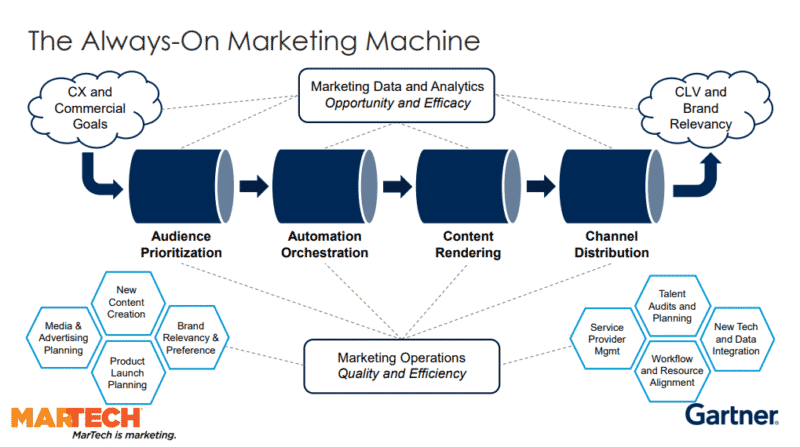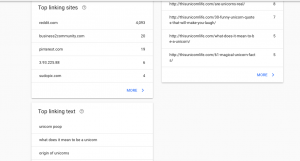You’ve gotten your team onboard. Now you need to know where to steer the ship.
In order to manage a successful digital transformation, marketing leaders have to assemble the team and technologies that will deliver the end goal, according to Michael McCune, Senior Director at Gartner, who spoke at our recent MarTech conference about the key components to the always-on marketing machine.
Each part of this machine’s subfunctions have clearly-defined end states that marketers should be aiming for as they go through their transformation process. They include audience prioritization, automation orchestration, content rendering and channel distribution.
These subfunctions aren’t newly created by the technology that your organization acquires, however. They just reinforce and optimize what you’ve already been doing the hard way.
“These all have a current state in your organization,” McCune stated. “You may manually identify and download an audience list, and maybe through discussion with colleagues you might determine what the next best action or experience is for that audience. And you might still be creating all related content from scratch and then manually distributing it across your various channels.”
He added, “The process exists even if you don’t see a system yet.”

Audience prioritization
The first link in the chain involves audience data and using analytics to prioritize your engagement with customers.
“This system doesn’t work without inputs,” McCune said. “We need to know where opportunities to enhance customer experience exist, and also where the predicted likelihood is of the next needed product or service.”
This audience engagement arm in the system also needs to be constantly updated and also needs to measure performance.
“We need to track the outcome of this system,” said McCune. “We need to see the impact with respect to customer lifetime value and brand relevancy. To do that well, and to guide each component of the machine, we need marketing data and analytics. It serves our ever present need to define where opportunity lies and analyze how well we are realizing the perceived value of that opportunity.”
This subfunction might seem like the kind of strategizing that is left to be done in person-to-person meetings, but it should be automated because it fuels the rest of the always-on marketing machine.
“Ultimately, audience prioritization will be automated using CLV and propensity models by telling us who would benefit from a nudge and avoid targeting someone who is going to act anyways or would never act,” said McCune.
He added, “I can tell you that the skill sets for modeling customer data and the technology for automated audience discovery absolutely exist. Now your data may not be in the best of shape, and your organization may not be politically ready for a CLV-based prioritization, but you also likely don’t have the budget to act against all of the audiences that the technology can identify for you.”
Marketing automation orchestration
You might not have the budget to reach all the likely targets who would benefit from the right message. You also might not have the necessary number of skilled team members to carry out all these functions. Yes, in order to fully automate the marketing machine, you need to orchestrate the automation with the help of marketing operations.
“The processes for doing this work in support of the always-on marketing machine need to be monitored continuously and improved for quality and efficiency,” said McCune. “And this is where marketing operations comes in and plays a role to complement marketing data and analytics.”
Essentially, organizations need to assemble the best automated triggers from the audiences that are surfaced on the predictive analytics side, and paired with the best content.
“It will serve our needs to explore and exploit opportunities that it senses, in collaboration with our customer analytics and content management systems,” McCune said. “That leaves most marketing leaders with the near-term headache of figuring out how to build the muscle of automation orchestration. Building a library of event-triggered actions is high calorie work and marketing needs to figure out how to persist through it and understand how to enable more staff to participate in it.”
Marketing operations is needed to help make consistent progress in developing a system around the event-trigger actions and pushed experiences in the always-on marketing machine, he explained.
Content rendering
Interestingly enough, not all subfuctions will progress at the same pace, in terms of becoming completely automated. McCune suggests that content prioritization might lag behind some of the other areas.
Make sure that any CMS in your stack is geared towards content optimization.
“[A CMS should be] expert at dynamically optimizing our content components and testing new versions of them,” he said.
“Content technology is the slow, complicated journey for everybody and that defined end state is quite far off, which means the promise of efficiency implied by this end state won’t be realized in the near term.”
That means you might attain the strategic shift toward CLV in your organization before you achieve content production efficiency. The most important thing is that your team is moving in the right direction on all fronts.
Channel distribution
“And of course all that content will be routed through the right channel at the right time with positive and negative outcomes registered in our customer data repositories,” said McCune.
“Decisioning around channel distribution, sending output and feeding outcome response data back to your customer data repository…true omnichannel omniscience is theoretically feasible, but ‘next best action in real time’ is not a common use case,” he stated, adding: “Most multi-channel marketing hubs that we see in operation are satisfying current needs.”
In this push to achieve the always-on marketing machine, it seems that most orgs are at some stage of changing tires while driving. By communicating clear end goals to the rest of your team members, you can make it a less-bumpy ride.
Watch the full presentation from our recent MarTech conference here (free registration required).
Snapshot: Marketing automation
For today’s marketers, automation platforms are often the center of the marketing stack. They aren’t shiny new technologies, but rather dependable stalwarts that marketers can rely upon to help them stand out in a crowded inbox and on the web amidst a deluge of content.
HubSpot noted late last year that marketing email volume had increased by as much as 52% compared to pre-COVID levels. And, thankfully, response rates have also risen to between 10% and 20% over their benchmark.
To help marketers win the attention battle, marketing automation vendors have expanded from dependence on static email campaigns to offering dynamic content deployment for email, landing pages, mobile and social. They’ve also incorporated features that rely on machine learning and artificial intelligence for functions such as lead scoring, in addition to investing in the user interface and scalability.
The post Building an always-on marketing machine appeared first on MarTech.
(29)







